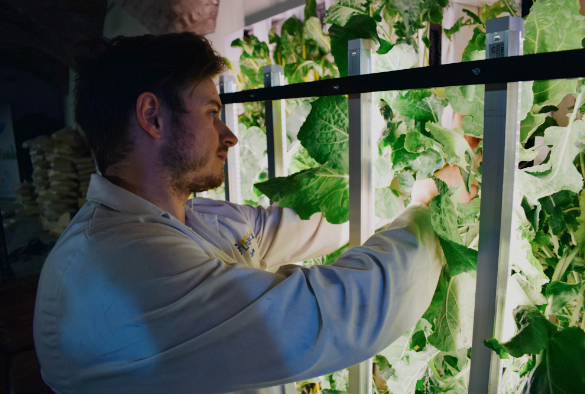Becoming an Expert: Could the future of farming be vertical?
Published on

Francis Baumont De Oliveira is a 2nd year PhD Student at the University of Liverpool’s Institute for Risk & Uncertainty, supported by the Low Carbon Eco Innovatory. Francis is collaborating with Farm Urban, a local social enterprise in Liverpool, UK.
Vertical farming has the potential to change the way we grow and think about food in cities. But this incipient industry is experiencing growing pains when it comes to profitability and proving claims of environmental sustainability. What is vertical farming and how can we nurture its embryonic growth?
So what is vertical farming?
Vertical farming is the practice of growing plants hydroponically in stacked layers or towers, typically indoors or on rooftops. It’s an incipient industry finding its feet and the technology is rapidly evolving, with a lot of hype buzzing around as of late. Growing plants in this way for food, seed breeding and biopharma products have a multitude of benefits: all-year-round production, up to 95% less water consumption and bringing agriculture into the city. It has the potential to introduce high-tech urban farming as a new profession at a time when our rural agricultural workforce is ageing and populations are becoming rapidly urbanised. We can vastly improve yields in a given space without destroying forests, using pesticides or depleting nutrients from over-farmed soil.
Despite all the perceived benefits of vertical farming, there are a few pinch-points in urban contexts. Firstly, the sky-high capital costs: affordable land within the city, indoor lighting, climate control equipment, irrigation systems, training … the list goes on. It’s certainly no cheap affair and the return on investment (ROI) of growing the viable crops isn’t ideal for most investors. Vertical farms are currently capable of growing leafy greens, herbs, edible flowers and some vegetables, as little energy is wasted on the inedible matter. Other staple crops, such as wheat, require a lot more light energy and therefore aren’t as economically viable. You need to sell the crops at a relatively high price if you want to make a reasonable margin. Which brings us to the operational pain-points: high energy demands, highly skilled labour demands and high staff turnover. The vertical farming landscape is littered with failed or shuttered projects – VertiCrop in Vancouver, FarmedHere in USA and Plantagon International in Sweden. With every project there are many lessons to be learned for the future. However, there are movers and shakers who are pioneering, beginning to pave the way, with successful projects popping up in Singapore, Japan, North America and more across the world.
Why did I choose this field?
I studied Aerospace Engineering for my undergraduate and masters degrees here in Liverpool. I took on a dissertation project in prototyping an aquaponic system with industry partner and start-up, Farm Urban. I was fascinated by the concept of Aquaponics, the cultivation of plants combined with aquatic animals to grow food. My passion for sustainability and curiosity about future food systems in space exploration drove me to pursue this area further. NASA, German Aerospace Centre and China National Space Administration are all investigating circular economy and food solutions for long-duration space missions. See NASA’s Lunar Greenhouse, Germany’s Neumayer III polar station, and China’s Lunar Farm.
I saw the potential to channel my skills in engineering and new-found vision of changing a broken-food system towards a brighter future. I became very engrossed in the project and was awarded the IMechE Best Project Award for the prototype. From this, doors opened and I was offered a PhD by Farm Urban to research future food production systems.
Prototyping one of Farm Urban’s desktop aquaponic systems
I chose to hone in on vertical farming, as innovation in the food system is fundamental to our species’ survival. Population growth combined with global megatrends of climate change, rapid urbanisation, food insecurity and water scarcity are increasing competition for resources and food. The current system of food production is at the heart of many of our challenges and is incapable of feeding the forecasted population of 9.77 billion by 2050. Amid this rapid growth, an estimated 850 million people go hungry every night and an additional billion do not get the nutrients they need in their diets.
“Imagine all the food mankind has produced over the past 8,000 years. Now consider that we need to produce that same amount again — but in just the next 40 years if we are to feed our growing and hungry world.” – Paul Polman, Chief Executive Officer of Unilever
This global instability desperately requires a food system which is secure, accessible and resource efficient. Vertical farming may not be the solution to all of these problems but it starts to make unprecedented links between sectors and spark the imagination of architects and visionaries. We can bring local food to the people and reconnect civilisation to its roots (once more growing food at the point of consumption). By integrating urban farms into unused spaces and providing value to local communities, we can work towards fully integrated urban farming models that also recycle or eliminate sources of waste.
My research
My PhD research is currently analysing the economic and environmental sustainability of vertical farms in urban contexts – how long can they last without further capital investment and what are the baseline metrics for comparing vertical farms environmental impacts? The purpose of the research is to analyse the risks facing vertical farms and develop a decision-making tool to facilitate resilient small-scale vertical farms. Can vertical farms economically sustain themselves? Paul Gauthier, Postdoctoral Research Associate at Princeton Environmental Institute, claims, based on a small sample, that around 85% of vertical farms go bust after several years without further capital investment – this solely looking at food production… Medicinal plants and marijuana production may yield better margins but are excluded from the sample. Achieving financial stability is certainly no easy feat, and growing plants densely in buildings is more like running a complex biological factory than running a farm. A high level of biosecurity is needed, as although the farm is protected from external weather phenomena, every condition or risk is magnified in a closed environment. There’s a lot of potential risks, evidenced by shuttered vertical farms. However, there is a lack of hard data on the reasons for failure. It all makes investing in vertical farms a little bit scary and unknown …
So after diving into the diverse literature, spread across academia, industry and policy, I’ve identified knowledge transfer, governmental policy and economic viability as the triangle of current limitations for vertical farms. In particular, a robust analysis of operating costs for running smaller vertical farms is needed. Tackling all three issues at once can only be done correctly by considering the inherent complexity of biosystems and the “Urban food-water-energy nexus“. A collaborative and multidisciplinary approach is required that combines sectors commonly seen as separate in urban planning. What about a planning tool that helps the user assess the risk of a project whilst suggesting mitigation strategies and providing knowledge from previous case studies? This tool would conduct economic analysis by using imprecise data techniques to accurately incorporate uncertainty based on historical data. The resulting risk assessment could be used to inform vertical farmers how to conduct due diligence, forecast ROI and secure potential investors, ensuring they’ve considered the risks encountered by other farms.
We’ve already established that there’s a lack of hard data, so how exactly can I conduct such research? Well, there’s a growing consensus that collaboration will be crucial for industry progression. Japan has started to pave the way for sharing lessons learned through its Japan Plant Factory Association (JPFA). The Association of Vertical Farming (AVF), and the UK based Urban Agritech Collective are also keen to improve the success rate of high-tech urban farms. The vertical farming puzzle is yet to be solved but a growing collective movement is starting to piece it together. I will go into the field and conduct interviews to identify the key risks, lessons learned, and use standard expert elicitation protocols to quantify the uncertainty and embed it into my economic model.
This rapidly evolving industry is in need of a methodical and scientific approach to risk assessment for vertical farming. The increasing collaboration and desire for shared knowledge exchange are exciting … getting a handle on this emerging industry will reinvent the way we think about our food.
Visit Francis' blog at https://francisbaumont.wordpress.com/
